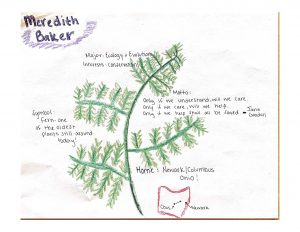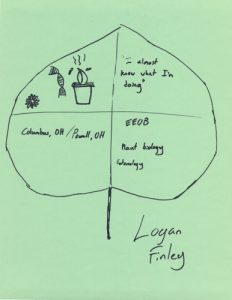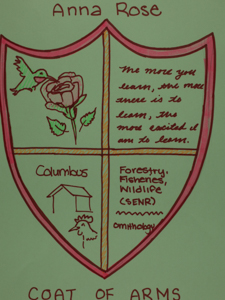OHIO PLANT SPECIES LISTS
with
CC VALUES (coefficients of conservatism)
and the
OHIO FLORISTIC QUALITY
ASSESSMENT INDEX
Coefficients of conservatism (CC) assigned to each species by Andreas et al. (2002). The CC, with values ranging from 0 to 10, is an estimate of the degree to which a species is associated with high-quality natural communities similar to those which existed in pre-settlement times. Exotic (alien, introduced) species are not assigned CC values.
The original FQAI REPORT published in 2004, also available as a direct download HERE (link).
An excel SPREADSHEET published in 2004 using older species names that may in fact be consistent with our older field guides, also available HERE (link).
***Best one: html version of 2014 list is available HERE (link).***
An excel SPREADSHEET of the 2014 update (converted from the html version) available as a direct download HERE (link).
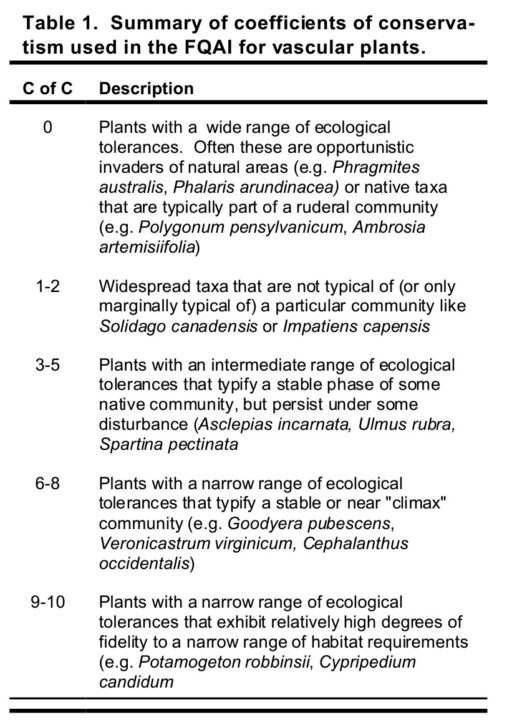
CEDAR BOG (that isn’t a bog)
Below, see some of the interpretive material that on display at the nature center.
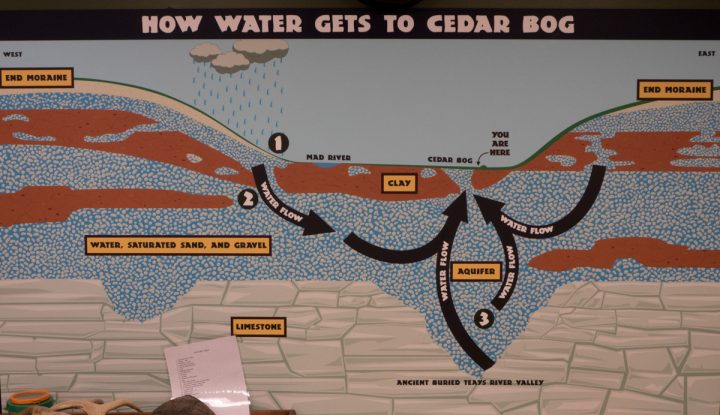
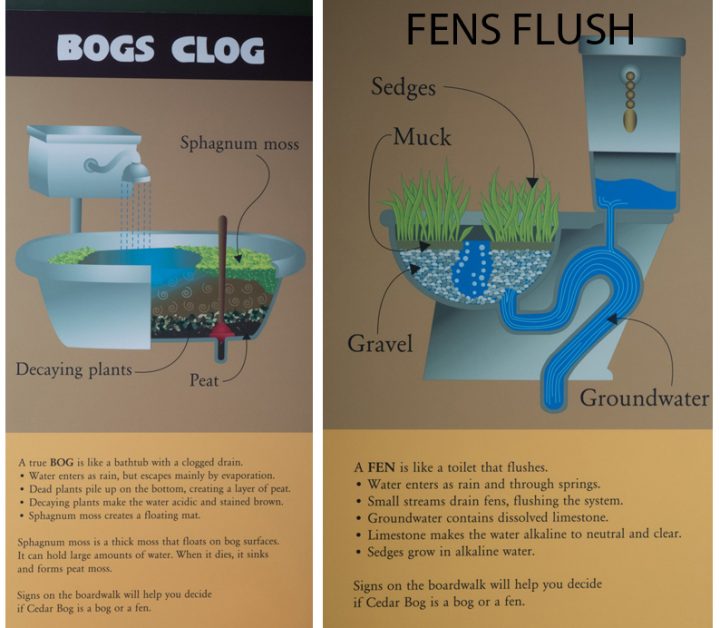
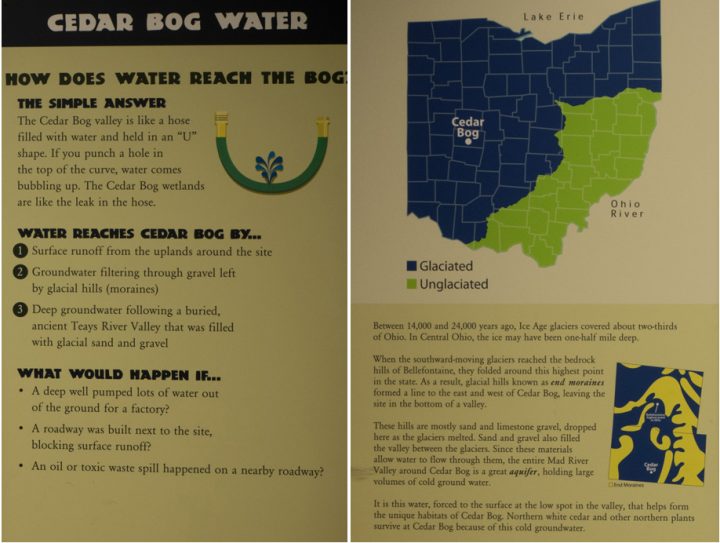
Additional information about Cedar Bog that isn’t a bog can be seen in the 1974 Ohio Journal of Science article by Clara May Frederick that can be read and downloaded HERE (link).

EEOB 2210 TERM PROJECT
BOTANICAL SURVEY
Effective stewardship of natural areas depends upon an accurate accounting of the biotic resources, particularly the vegetation, present on a site. The development of a site-specific plant species list, along with a written description of the plant communities that are there (including relevant information about the human and natural ecology of the plants) is often desired by natural resource agencies, landowners, and environmental organizations. This substantial (100 point) assignment is to perform and document a botanical survey like the ones performed by professional field botanists engaged in environmental assessment. The specifications for this project are here (link to .pdf below)
BOTANICAL SURVEY INSTRUCTIONS
SAMPLE BOTANICAL SURVEY
HERE ARE RECOMMENDED SITES
(touch-screen navigate using 2 fingers)
HERE ARE RECOMMENDED SITES
(touch-screen navigate using 2 fingers)
WEEK 2: DENDROLOGY (trees) WEB PAGE ASSIGNMENT
Due Sunday September 1 (credit 20 pts.)
Tree Assignment Content Guidelines: For context and inspiration, read this article in a recent New York Times (LINK). Cite and expand upon the points that Popkin makes in your tree page.
This week we will apply and extend the tree identification skills that we learned last week. Go out into the world and discover 8 wild (not cultivated) broad-leaved (not conifer) trees. Identify them to species using your Peterson’s Field Guide to Trees and Shrubs. At least half of them must belong to different genera than the 8 we learned in class. Photograph your 8 trees close enough up (close up enough?) (up close enough??) (up with enough closeness???) to see the features that allow it to be recognized for what it is. Provide two photos of each tree –one showing the overall shape and form, and one showing leaf details. To acheive further fame and glory, include some pictures of the bark or the fruit, if present.
Provide the following information about each tree:
-
- common and scientific names, the latter written properly in terms of capitalization and italics.
- a written description of the pertinent identification features: leaf arrangement, complexity, and other traits that, taken together, distinguish that particular species.
- where you saw the tree, both the site locations and the habitat (the type of environment, i.e., swamp forest), and any impressions you had of thr tree and the setting. What was it like to meet this tree?
- for each tree, provide TWO interesting statements about the tree’s human or natural ecology that you hadn’t known before, from the following sources.
—ONE of the the facts needs to come from your field guide, and be cited (copy/paste) as such (Petrides, George A. 1972, Trees and Shrubs of Northeast and North Central US and Southeast and South Central Canada (Peterson Field Guide). Houghton Miflin, 428 pp.).
—ANOTHER of the facts should be from a reliable and interesting internet source and must be cited, both by site name and hyperlink. Here are four recommendations, properly cited:
1. Lady Bird Johnson Wildflower Center Native Plant Information Network (ACSA2)
2. Native American Ethnobotany: A Database of Foods, Drugs, Dyes and Fibers of Native American Peoples, Derived from Plants.
3. Minnesota Wildflowers
4. Illinois Wildflowers - Do please have fun with this; be creative, and be sure to compare your experiences with the ones recounted by Gabriel Popkin in the “Tree Blindness” article you read.
Some exemplary web sites from past classes are the following. Check out their TREES pages for inspiration and format guidance.
From the Archives: Examples of Really Good Student Web Sites
Let’s Set Up Web Sites
(pages not posts; full width, no sidebars)
Hi ho Botanists! In class on Wednesday you all were assigned a name that you will use as the name (web address) of your new u.osu.edu web site. For example, Brett’s site is https://u.osu.edu/asarum5/. Follow the instructions in the video below, being sure to adhere to the following principles:
Steps for creating websites:
- Change theme to Orton (top left of page)
- Go to dashboard then to posts and remove default post (we won’t be using posts)
- While on dashboard, add new page called Home and immediately change template to Full-Width no sidebar (should be on right-hand side of page)
- Add a picture and short introduction then hit publish
- Next, delete the sample page
- Next (still on dashboard), make the Home Page static by going to Settings -> Reading -> Make Static Page and select your Home Page.
- Click Visit Site. One loaded, hit the Customize Tab (Top left of page) and add a botanically inclined header image (Large or Full Size!)
- Make new Pages for each field trip and/or assignments with large or full size pictures and captions for information.
- Email with any questions/issues (lambert.648)
Have fun with this!
LINKS TO WEB SITES

LINKS TO WEB SITES
WEB PAGE QUESTIONS
WEDNESDAY LAB
A.J.S., in their TREES OF OHIO page, they tell us of the military importance of white oak. What is that historical connection?
Al N., in their WAHKEENA THE APPLACHIAN GAMETOPHYTE AND OHIO GEOBOTANY page, tells us how to recognize greenbriar by its leaf veination. How?
Allie C., on their BATTELLE DARBY METRO PARK page, lets us that eastern hophornbeam is a very fun tree, citing three simarities to other things (each using the woed “like”). What are those 3 fun similarities?
Andrew W., on their TREES web page relate an intersesting feature of red oak buds. What is that?
Blaine P., on their TREES page explains why white mulberry was introduced to the Americas. Why did they do that?
Caitlyn K., on their DEEP WOODS page tell us about the edibility of cinnamon fern, telling us it edible and it is toxic. Explain!
Christian B., “interviewed” 8 trees at SHARON WOODS METRO PARK and while shaking hands with hackberry noted something peculiar on the leaves. What was that, and what was its causitive agent?
David D., on their TREES page tells of a medicinal use for slippery elm. What is that?
Dr. Klips, on their TREES I KILLED page mentioned what happens when you scratch a black cherry twig. What happens, and to what is it attributable?
Emma H., on their PLANTS OF THE OLENTANGY RIVER WETLANDS RESEARCH PARK shows a photo of a tree fruit that looks (to me at least) like a smiley-face emoji! (Now you can’t unsee it, right?) What is the tree, and how does the shape of this fruit help differentiate it frolm another, much rarer, congener?
Ethan H., on their PLANTS OF BLENDON WOODS page gives a reason why autumn-olive does so well on poor soil. What is that (it’s something about the roots)?
Holly E., on their TREES page, suggets a fun activity for a fall day that involves black walnut. What is that activity?
Jaylyn F., on their CEDAR BOG *which really is not a bog) page, gives nice descriptions of the vegetation in different layes of both major communuities. What did they find in the ground cover layer of the fen?
Maddie M., on their DEEP WOODS page shows us the invasive Japanese stilt grass, and tells how it might have been brought to this country. How and why?
Morgan C., on their PLANTS OF ADENA BROOK page shows us hawthorn, and mentions its medicinal use. What is its medicianal use?
Nate H., on their PLANTS OF GLEN ECHO PARK page shows us a golderod. Which particular one is it, how is it unusual in terms of the environment it growes in, and what is one ecological benefit?
Olivia G., on their TREES!! page, tells us that the hugr thorns of honey locust may have (in the past) acted as a defense against whaaaat?
Zoey H., on their BOTANICAL SURVEY page, points out narrow-leaved cat-tail, and sets forth two reasons/mechanisms it is invasive. What are those two reasons/machanisms?
THURSDAY LAB
Alex A., on their BDMP + CEDAR BOG (FEN) FIELD TRIP page shares with us a “fun Fact” that got changed to a “fatal fact” (Aside from that Mrs. Lincoln, how did you enjoy the play?) concerning an understory plant at BDMP. What was the plant and the reason for the “f-word” switcharoo?
Alex S., on their DEEP WOODS FARM page describe a key aspect of Japanese stilt grass reproduction that needs to be addressed in order to control it. What is this control strategy?
Bradley M., on their PLANTS OF HEFNER WETLANDS page, informs us of an insect that benefits from pawpaw. What is that, and how does it benefit?
Brendan S., on their BATTELLE DARBY METRO PARK + GEOBOTANY page, explain that sneezeweed doesn’t make us sneeze, How then did it get that name?
Emily S., on their (wait for it) BATTELLE DARBY METRO PARK AND CEDAR BOG (not a bog) BLOG (not a blog) page shows us moonseed. To what human use has moonseed been put?
Emma T., on their PLANTS OF GLEN ECHO page, give a neat demo of “glaucous” using black raspberry as the model organism. Describe what was shown, thereby defining the term.
Hannah S., on their CEDAR BOG (Cedar Fen? page give a good description and citation of many plants that make up the the swamp forest community. Thres of them, actually have “swamp” in their common name. What are these three plants?
Hannah T., on their DEEP WOODS page, relates medicinal uses of eastern hemlock. What are/were they?
Jayson D., on their TREES web site, advises us “Watch out!” for honey locust. Why the startled reaction?
Kade H., on their DENDROLOGY web page, tell us about a medicinal use of eastern cottonwood. What is that use, and to what chemical component is it attributable?
Katie B. on their PLANTS OF WHETSTONE PARK page shows us poison ivy–nice–and then down a bit says “So I bet you are asking why I am showing you another picture of poison ivy! Well good on you for paying attention, but…” What are we actually shown and how can we tell it from the dreaded p.i.?
Regan B., on their PLANTS OF THE LOWER OLENTANGY ECOSYSTEM RESTORATION page shows us pawpaw, and sets forth a way in which this tree is superlative. How so?
Sammy M., on their TREES page gives a reason why fisherfolk might seek out common catalpa. Why might they do that?
Shelby B., on their DEEP WOODS, THE APPALACHIAN GAMETOPHYT AND OHIO GEOBOTANY page shows us chestnut oak, and mention that, as an oak, it may have “galls.” What are they, as explained by Shelby?
Taylor O., on their PLANTS OF INDIAN VILLAGE page shows us the invasive purple loosestrife, and mentions a way of controlling it that is very ecological, and doesn’t include herbicides. What is that control method?
Zoe S., on their DEEP WOODS page mentions five (!) plants in the genuc Vaccinium,. What are they?

